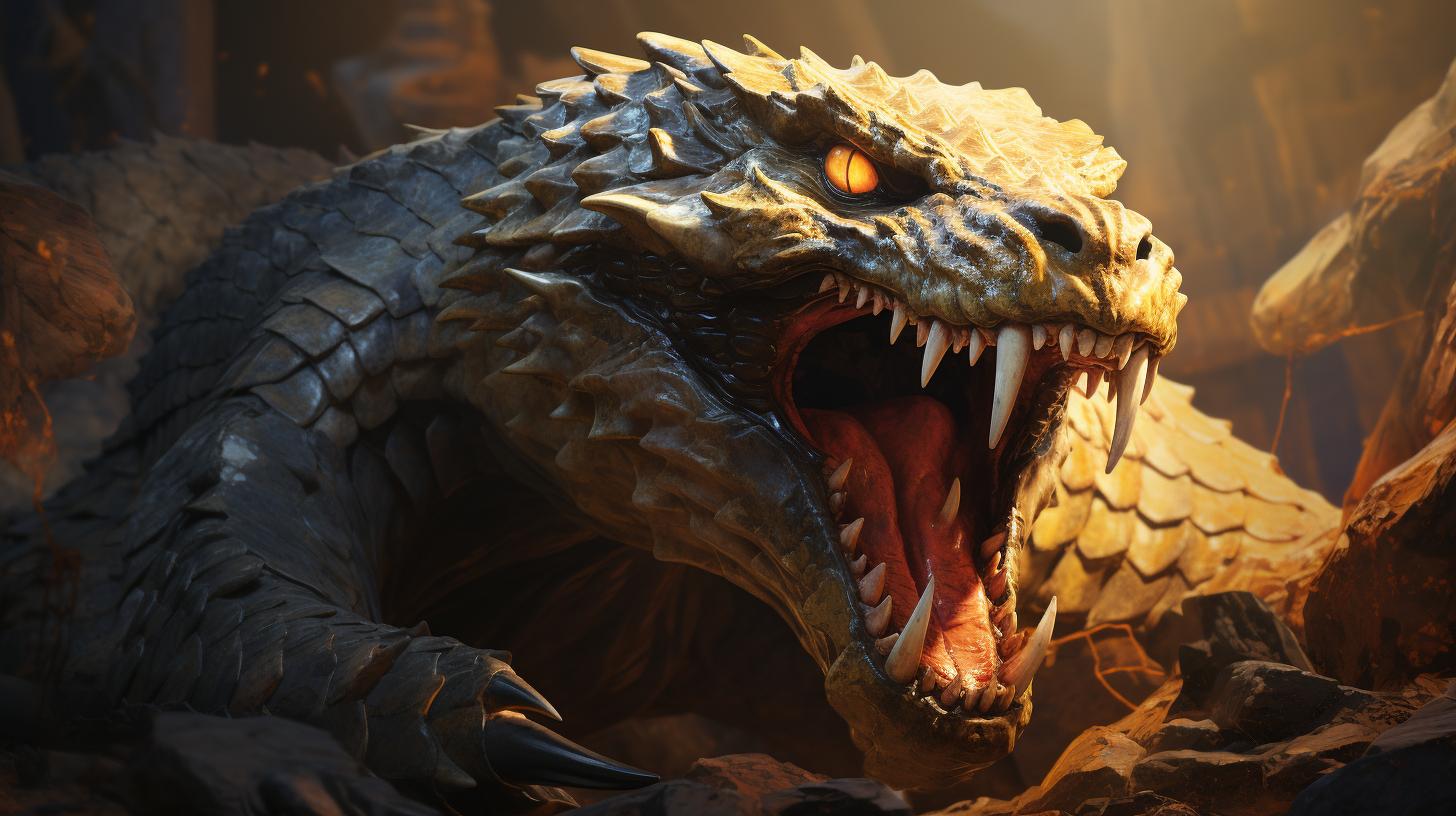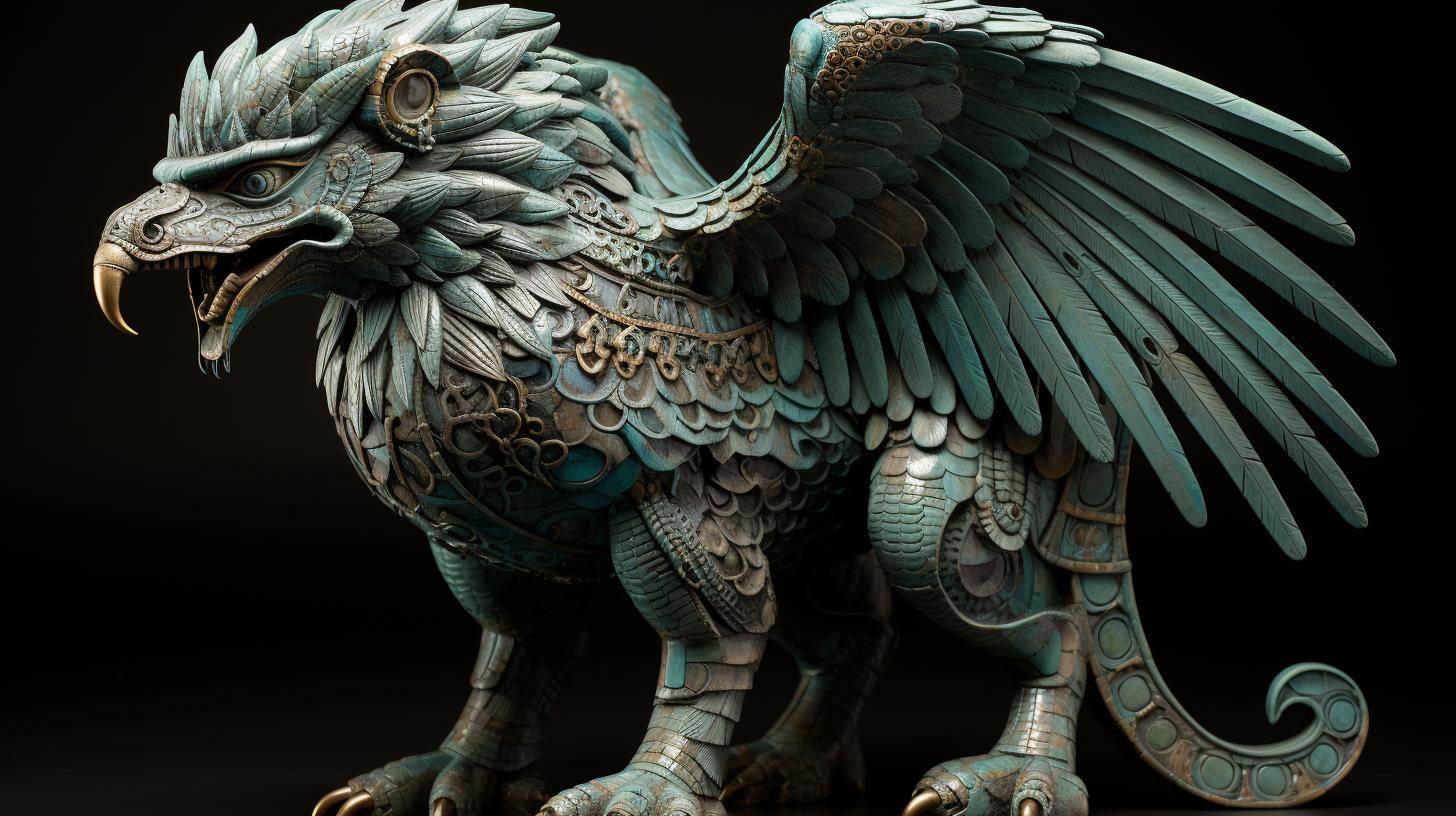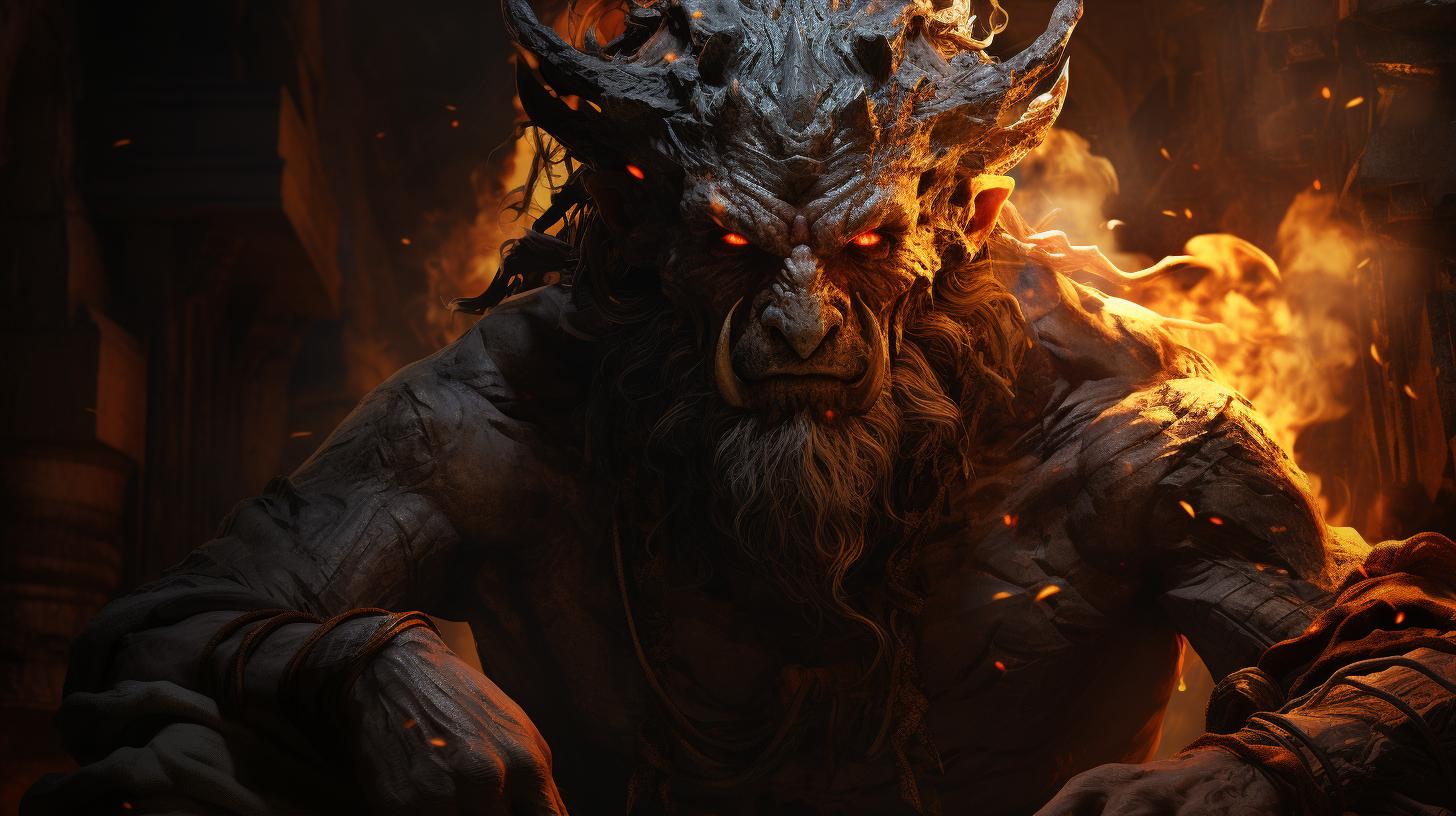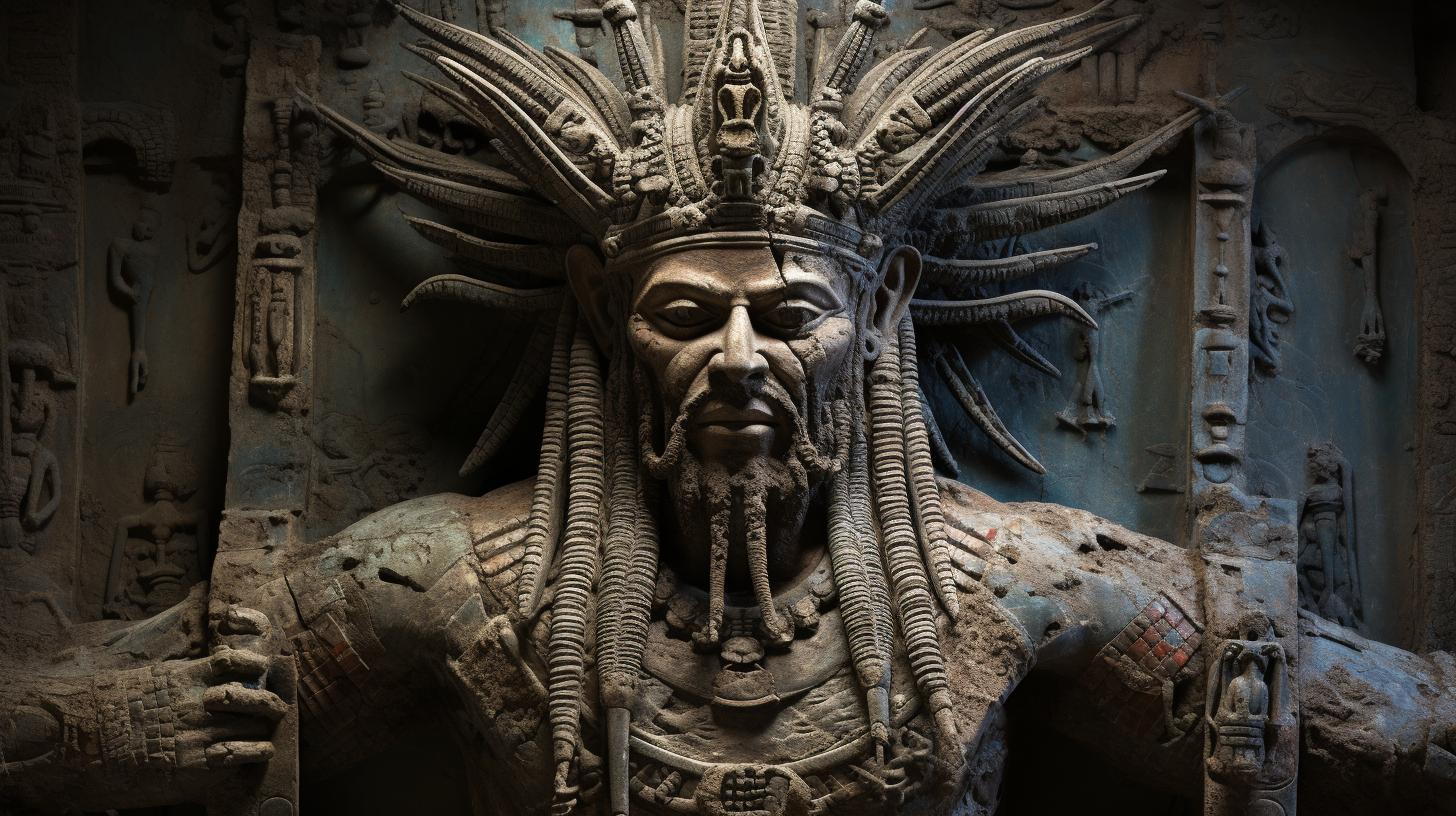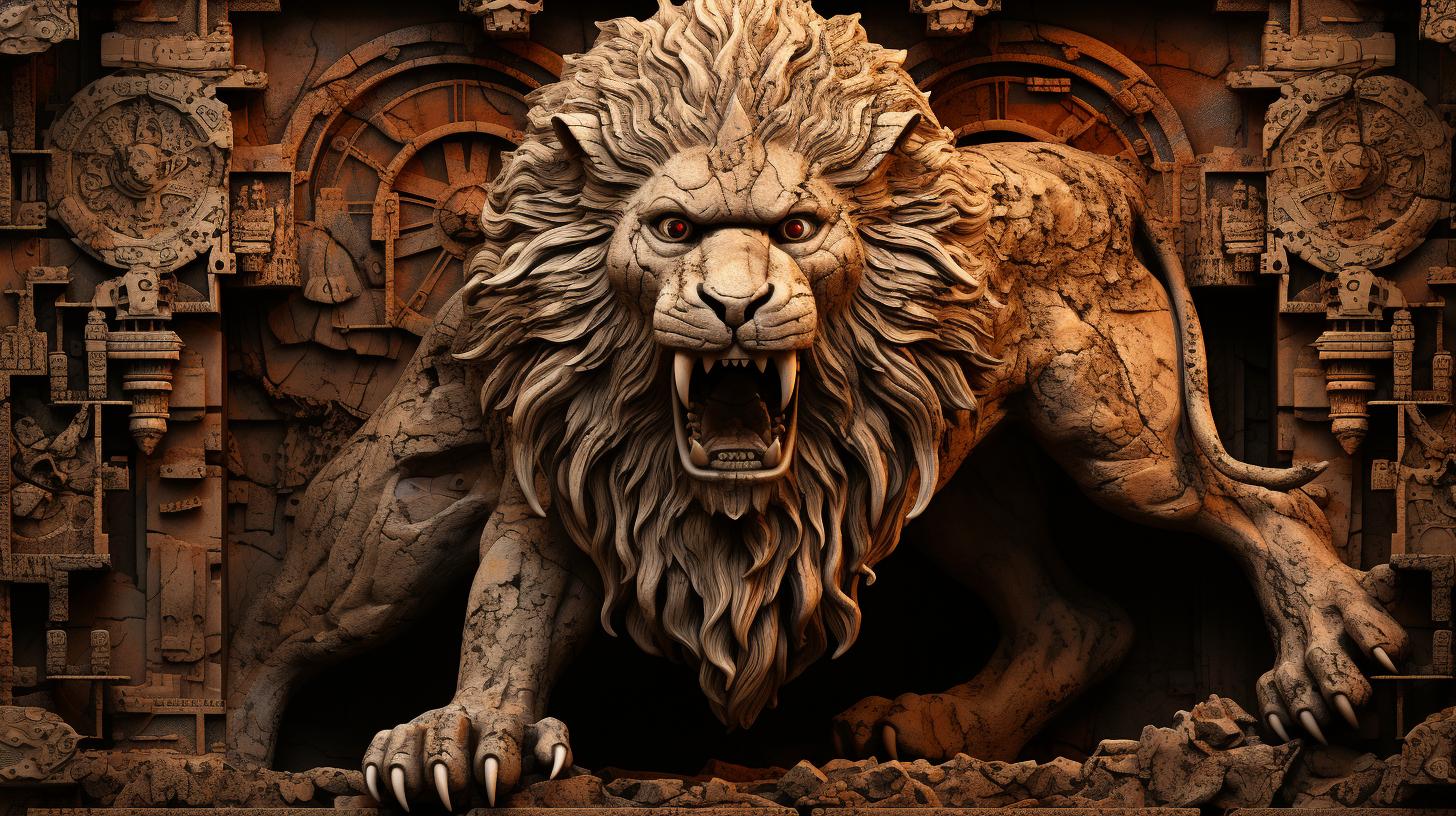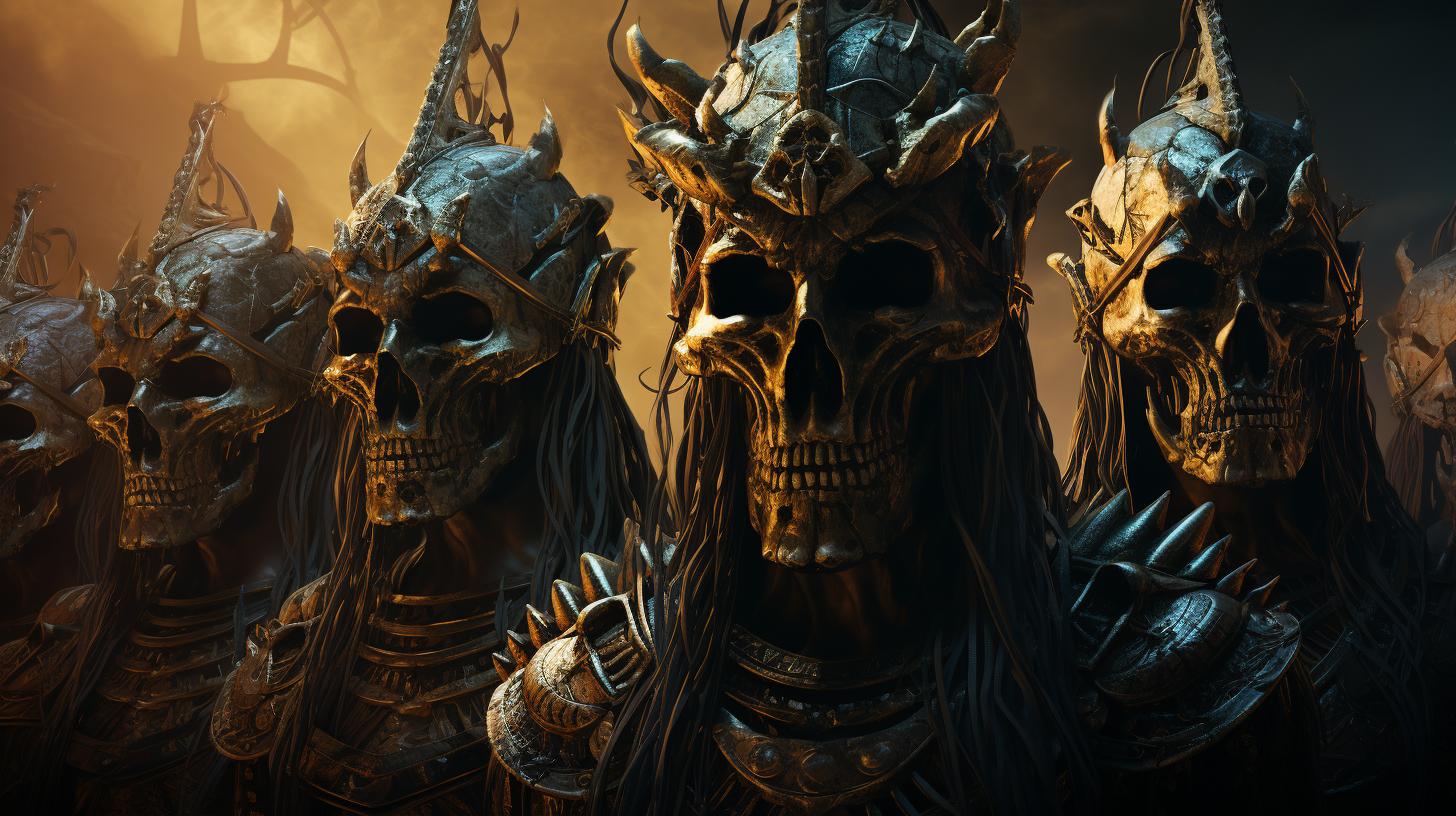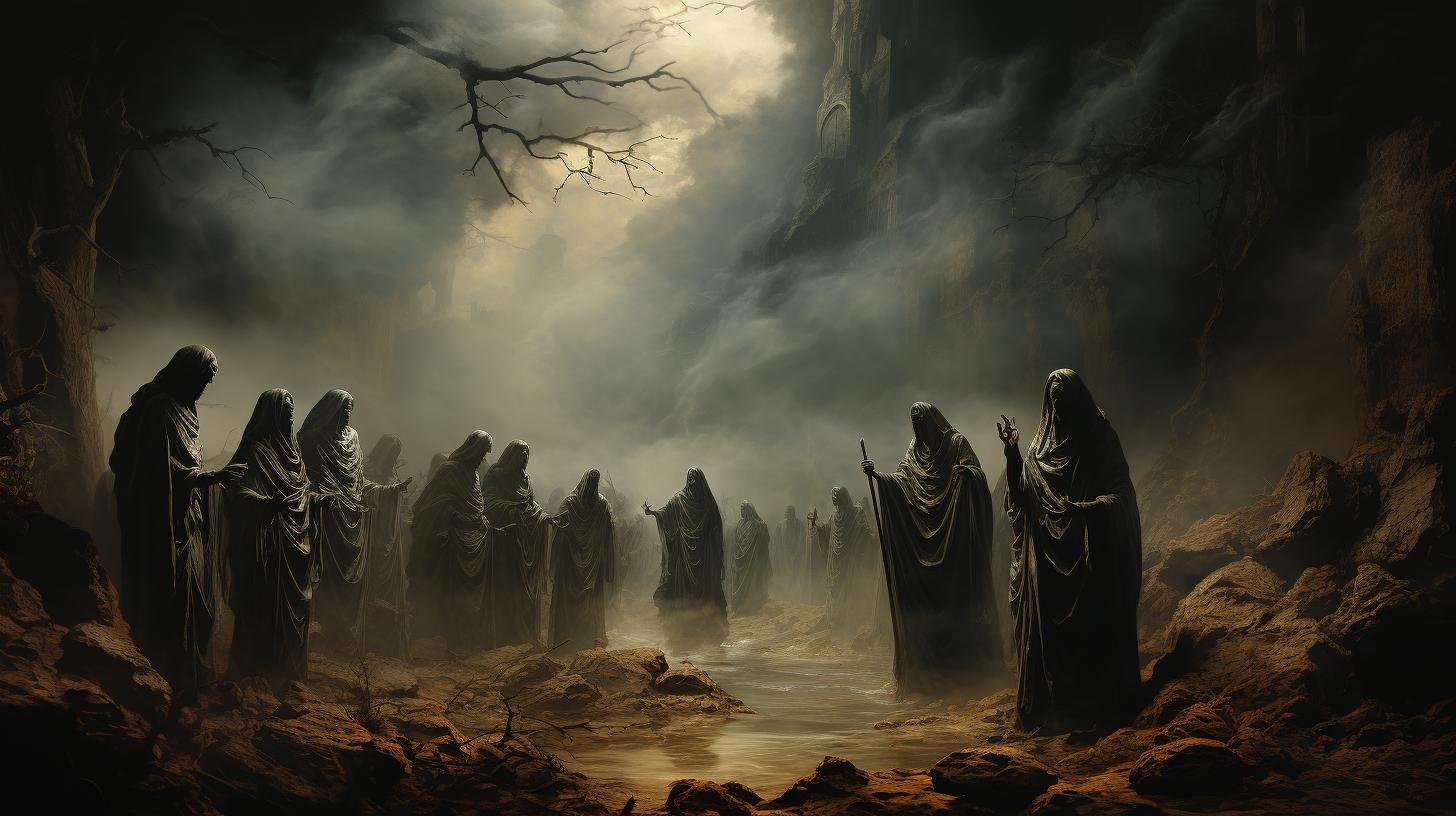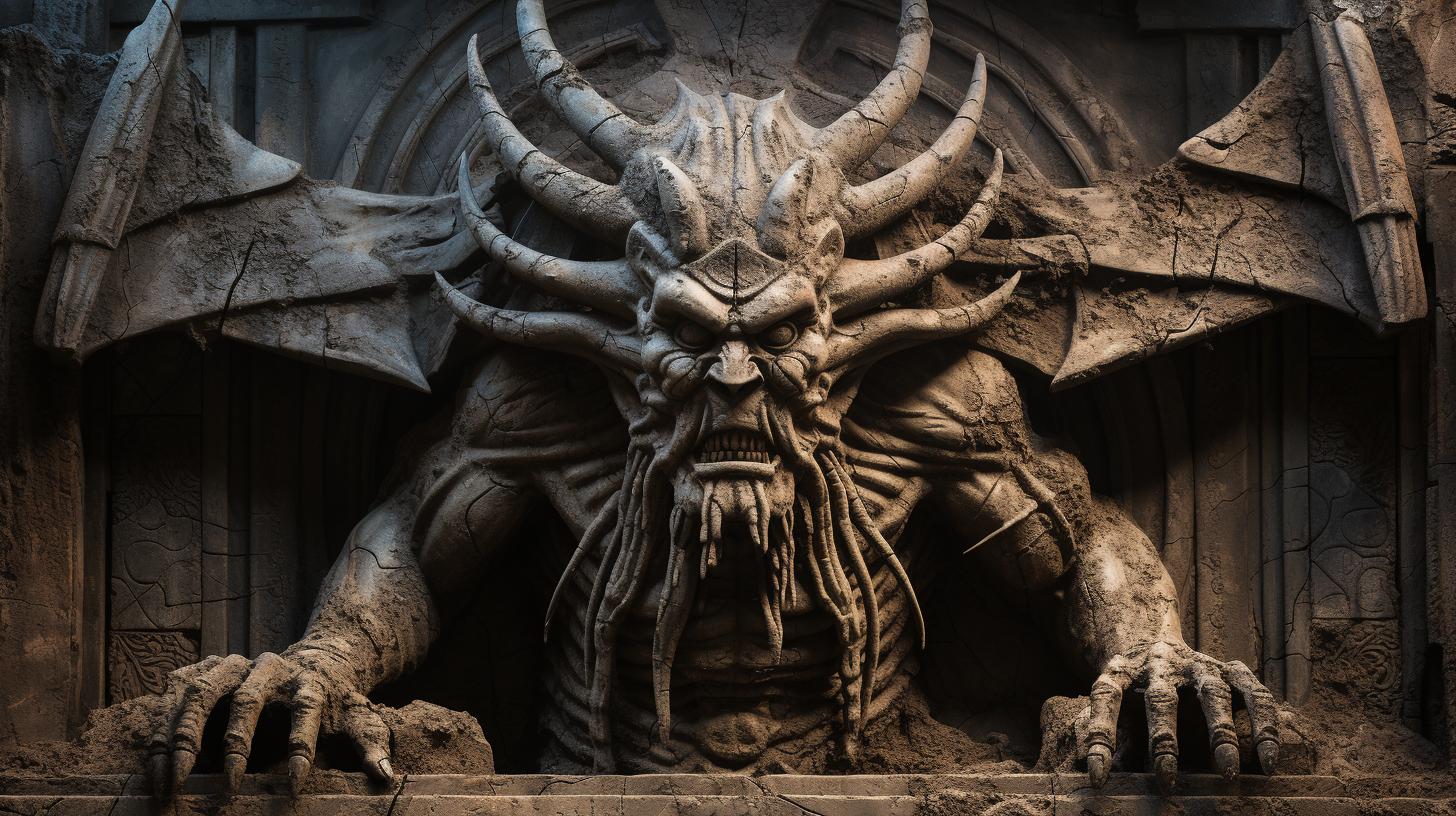Basmu Mythology: Unveiling the Mysterious Power of the Horned Serpent

Basmu mythology is a fascinating ancient Mesopotamian belief centered around the powerful and fearsome creature known as the horned serpent. This mythical serpent, described as a giant multi-headed snake covered in scales, holds the ability to control elements like fire and water, often associated with storms and natural disasters.
Created by the primordial goddess Tiamat, Basmu played a significant role in the conflict between Tiamat and the younger gods. Its venomous nature, fiery breath, and association with chaos highlight its destructive power in Mesopotamian culture.
Explore the enigmatic world of Basmu mythology through various aspects, from its origins and symbolism to its connection with ancient beliefs and literature.
Overview of Basmu Mythology
In the realm of ancient Mesopotamian mythology, Basmu holds a significant place as a powerful and awe-inspiring creature. Known as the horned serpent, Basmu is described as a colossal snake adorned with multiple heads and covered in formidable scales.
Its origins trace back to the primordial chaos and the sea goddess Tiamat, who created eleven monstrous creatures to aid her in the battle against the younger gods.
- The Mythical Beings in Sumerian Gods and Basmu Mythology
In the intricate tapestry of Mesopotamian mythology, Basmu stands alongside other mythical beings who are prominent within the pantheon of Sumerian gods.
These divine creatures played diverse roles in the ancient stories and legends, adding depth and complexity to the belief system of the time. Exploring the connections between Basmu, Tiamat, and the other entities within this mythological framework unravels the intricate web of symbolism and significance woven throughout these ancient tales.
- Unraveling the Mystery of Mushussu in Basmu Mythology
One intriguing aspect of Basmu mythology is the relationship with the creature known as Mushussu. Often depicted as a hybrid with the body of a serpent, horns of a gazelle, and the forelegs of a lion, Mushussu holds a significant place within Mesopotamian lore.
Diving into the contrasting characteristics and symbolic meanings associated with both Basmu and Mushussu reveals the depth and richness of the ancient mythology surrounding these enigmatic beings.
- The Influence of Basmu on Ancient Beliefs and Culture
Basmu’s presence reverberates beyond the myths themselves, leaving an indelible imprint on the ancient beliefs and culture of the Mesopotamian civilization.
As a potent symbol of chaos and destruction, it served as a reminder of the capricious and uncontrollable forces of nature. Delving into the influence of Basmu on religious practices, artwork, and societal conventions sheds light on the profound impact this mythical creature had on the collective consciousness of the ancient Mesopotamians.
- Basmu as a Symbol of Chaos and Destruction
Basmu’s association with chaos and destruction embodies the ancient Mesopotamian understanding of the elemental forces of the world. Its venomous nature and ability to breathe fire highlight the destructive power of both flames and the uncontrollable chaos they can unleash.
Exploring the widespread symbolism and representations of Basmu’s fiery nature provides insights into the ancient Mesopotamians’ recognition of the devastating potential inherent in the elements.
- The Connection between Basmu and Protective Spirits in Mesopotamian Mythology
Within the intricate tapestry of Mesopotamian mythology, Basmu’s role extends beyond chaos and destruction. It shares a connection with the protective spirits, known as apkallu.
These divine beings acted as intermediaries between gods and humans, offering guidance and safeguarding individuals against malevolent forces. Unraveling the connection between Basmu and the apkallu allows us to gain a deeper understanding of the interplay between destructive and protective forces in Mesopotamian cosmology.
- The Legend of Basmu and its Relation to Other Mesopotamian Myths
Examining the legend of Basmu in the broader context of Mesopotamian myths provides valuable insights into the interconnectedness of various narratives within the ancient belief system.
By tracing its threads through stories of creation, divine conflicts, and heroic quests, we begin to comprehend the intricate mosaic of Mesopotamian mythology, where Basmu serves as a pivotal figure influencing epic sagas and shaping the worldview of the ancient Mesopotamians.
- Comparative Analysis: Basmu in Ancient and Modern Literature
Comparing the portrayal of Basmu in ancient Mesopotamian literature with its appearances in contemporary works offers a cross-cultural perspective on the enduring appeal and significance of this mythical creature.
Exploring the reinterpretation of Basmu across time and cultural boundaries provides valuable insights into the evolving perceptions of ancient myths and their continued relevance in modern storytelling.
- Reinterpreting Basmu Mythology: New Perspectives and Insights
As the study of Mesopotamian mythology continues to evolve, novel perspectives and insights shed light on the enigmatic world of Basmu.
By venturing into uncharted territories, scholars explore new methodologies and interdisciplinary approaches to unravel the intricacies of Basmu mythology. These fresh interpretations contribute to our ever-expanding knowledge, enabling us to grasp the depth and significance of this ancient belief system in unprecedented ways.
Origins and Significance of Basmu Mythology
The origins of Basmu mythology can be traced back to the ancient Mesopotamian civilization, specifically the land we know today as Iraq. This mythology revolves around a fearsome creature, the horned serpent, known as Basmu.
Basmu is described as a gigantic snake with multiple heads and scales covering its entire body.
According to ancient Mesopotamian beliefs, Basmu was created by the powerful goddess Tiamat, the primordial deity of chaos and the sea.
Tiamat, seeking assistance in her battle against the younger gods, created eleven monstrous creatures, and Basmu was one of them. In this way, Basmu became intricately connected to the cosmic struggle between Tiamat and the younger gods.
The significance of Basmu mythology lies in its reflection of the ancient Mesopotamians’ understanding of the natural world. Basmu represents the immeasurable power of chaos and destruction, reminding the people of the uncontrollable forces of nature.
With its association with elemental control, particularly fire and water, Basmu embodies the ancient Mesopotamians’ recognition of the devastating effects these elements can have.
Basmu’s venomous nature and ability to breathe fire further emphasize its role as a formidable and dangerous creature in Mesopotamian mythology.
The ancient Mesopotamians recognized the destructive potential of fire and believed that Basmu’s fiery breath symbolized their understanding of the element’s capacity to cause immense harm.
The significance of Basmu mythology extends beyond its representation of chaos and destruction.
It permeated various aspects of ancient Mesopotamian culture, influencing their beliefs, rituals, and even literature. The tales surrounding Basmu were passed down through generations, preserving the ancient wisdom and providing insights into their worldview.
Overall, the origins and significance of Basmu mythology capture the ancient Mesopotamians’ awe and respect for the profound mysteries of the natural world. Through the creation of Basmu, the goddess Tiamat, and the conflict between the deities, this mythology offers a unique glimpse into the ancient civilization’s cosmology and their understanding of the power and unpredictability of nature.
Exploring the Role of Tiamat in Basmu Mythology
The role of Tiamat in Basmu mythology is crucial in understanding the origins and significance of this ancient belief system. Tiamat, the primordial goddess of chaos and the sea, played a pivotal role in the creation of Basmu and other monstrous creatures.
In Mesopotamian mythology, Tiamat was seen as the embodiment of the chaotic and destructive forces of nature. It was believed that she created Basmu and eleven other monstrous beings to aid her in a fierce battle against the younger gods.
Tiamat’s role as the creator of Basmu highlights her power and influence in the mythological narrative. As the mother of these monstrous creatures, she symbolizes the forces of chaos and the unpredictability of nature.
Furthermore, Tiamat’s association with the sea adds another layer of symbolism to Basmu mythology. Just as the sea can be both nurturing and destructive, Basmu represents the duality of power and danger.
The conflict between Tiamat and the younger gods represents the struggle between order and chaos, civilization and the primal forces of nature. Basmu’s existence as one of Tiamat’s creations exemplifies the perpetual tension between these opposing forces in ancient Mesopotamian belief.
By exploring Tiamat’s role in Basmu mythology, we gain a deeper understanding of the complex dynamics and symbolism within this ancient belief system. Tiamat’s power, as the creator and mother of Basmu, reflects the intricate relationship between divinity, chaos, and the natural world.
The Mythical Beings in Sumerian Gods and Basmu Mythology
Within the rich tapestry of Sumerian mythology, the presence of mythical beings intertwines with the captivating tales of Basmu. These ancient texts reveal a world teeming with diverse and awe-inspiring creatures, each contributing to the intricate lore surrounding Basmu mythology.
One of these extraordinary beings is the Anzu bird, known for its immense size and wingspan. In Sumerian mythology, this majestic bird is depicted as a formidable creature of great strength and intelligence.
It is said to possess the ability to summon storms and represents both devastation and rebirth. The Anzu bird’s role in Basmu mythology remains unclear, but its connection to storms and power make it a fascinating entity worthy of exploration.
Another significant mythical being is the Lamassu, a protective deity depicted as a hybrid creature with the body of a lion and the wings of an eagle. These colossal figures often stood guard at the entrances of important buildings and acted as symbols of strength and divine protection.
In the context of Basmu mythology, the Lamassu’s presence adds layers of symbolism and spiritual significance, perhaps serving as a guardian against the chaos and destructive forces associated with Basmu.
Furthermore, the ubaid is another mythical creature mentioned in Sumerian mythology, often described as a humanoid figure with amphibious features. These beings were believed to possess an intrinsic connection to the natural world, particularly the water element.
In the context of Basmu mythology, the ubaid’s association with water might offer insights into Basmu’s control over the elements and further highlight the serpentine deity’s extraordinary powers.
These mythical beings, among many others, contribute to the rich tapestry of Sumerian gods and Basmu mythology. Their presence infuses these ancient tales with a sense of wonder and mysticism, offering glimpses into the intricate beliefs and cultural tapestry of the Mesopotamian civilization.
Unraveling the Mystery of Mushussu in Basmu Mythology
Mushussu, a fascinating creature in Basmu mythology, is a key figure that holds much intrigue and symbolism. This serpent-dragon hybrid is often depicted with a snake’s body, eagle’s talons, and lion’s head.
Its unique appearance captures the imagination and deepens the mystery surrounding its role in Mesopotamian mythology.
One of the significant aspects of Mushussu is its association with the god Marduk, who played a pivotal role in the Babylonian creation story.
This divine creature was said to be Marduk’s primary companion and guardian, standing by his side during his epic battle against Tiamat.
Mushussu’s presence during this great conflict highlights its importance as a protective and powerful force against chaos and destruction.
It was believed to possess the ability to vanquish evil and maintain order in the universe. In ancient Mesopotamian culture, Mushussu symbolized strength, resilience, and divine protection.
Beyond its symbolic role, Mushussu also had practical significance in the ancient world.
It served as a protective spirit, guarding important spaces such as gates and palaces. The depiction of Mushussu on city walls and prominent buildings acted as a visual deterrent against malevolent forces, reinforcing the belief in its power.
The symbolism and representation of Mushussu go beyond its physical attributes. It evokes a sense of awe and reverence, embodying the ancient Mesopotamians’ collective fear and veneration for the unknown forces of the universe.
Through the study of ancient texts and archaeological findings, scholars continue to piece together the full extent of Mushussu’s significance in Basmu mythology. Each discovery adds another layer to the rich tapestry of this enigmatic creature and its place within the ancient Mesopotamian belief system.
The Influence of Basmu on Ancient Beliefs and Culture
Basmu, the fearsome horned serpent of Mesopotamian mythology, wielded a significant influence on the beliefs and culture of the ancient civilization. The awe-inspiring presence of Basmu in mythology shaped the Mesopotamian worldview and left an indelible mark on various aspects of their society.
One of the most notable impacts of Basmu mythology was its association with chaos and destruction. The ancient Mesopotamians regarded chaos as an inherent force in the universe, capable of both creation and destruction.
Basmu, with its fiery nature and association with elements like fire and water, personified this chaotic energy. This perception of chaos influenced not only their religious beliefs but also their understanding of the unpredictable and uncontrollable forces of nature.
Furthermore, Basmu’s portrayal as a creature created by the primordial goddess Tiamat played a pivotal role in the Mesopotamian cosmogony. Tiamat represented the primeval chaos and the ever-present threat to the order established by the younger gods.
As one of the monstrous offspring of Tiamat, Basmu embodied the perpetual struggle between chaos and order in the universe. This duality resonated deeply with the Mesopotamians and helped shape their religious narratives and rituals.
The influence of Basmu extended beyond religious and cosmological beliefs, impacting various aspects of Mesopotamian culture. The symbolism of Basmu as a creature of immense power and danger instilled a sense of fear and reverence among the ancient Mesopotamians.
This awe-inspired respect for the forces of nature and the recognition of their potential destructive capacities shaped their approach to agriculture, architecture, and survival in a challenging environment.
Moreover, Basmu’s association with storms and natural disasters contributed to their understanding of calamities and the need for protective measures.
The concept of protective spirits and rituals to appease these forces emerged as a response to the perceived wrath of Basmu and its ability to unleash destructive forces in the form of floods, droughts, or wildfires.
These precautions became integral to their daily lives and further solidified the influence of Basmu on their cultural practices.
In conclusion, the influence of Basmu on ancient Mesopotamian beliefs and culture was profound.
Its association with chaos and destruction shaped their perception of the universe, while its role as a symbol of power and danger instilled a sense of respect and awe. The influence of Basmu extended beyond the realm of mythology, impacting various aspects of their culture, including religious rituals, societal practices, and their relationship with nature.
In this way, Basmu mythology played an integral role in shaping the worldview and cultural identity of the ancient Mesopotamians.
Basmu as a Symbol of Chaos and Destruction
The mythological creature Basmu holds a significant place in Mesopotamian beliefs as a potent symbol of chaos and destruction. This fearsome serpentine entity embodies the unpredictable forces of nature and serves as a grim reminder of the power that can bring devastation.
Depicted as a colossal horned serpent with multiple heads and scaled skin, Basmu embodies the raw and untamed energy of chaos. Its association with fire further intensifies its symbolism, as fire has long been recognized as a destructive element capable of causing massive harm.
Throughout Mesopotamian mythology, Basmu’s fiery nature has been linked to cataclysmic events such as storms and natural disasters. Its ability to control not only fire, but also water, further strengthens its reputation as a symbol of chaos.
The dual dominance over opposing elements signifies the unstoppable force that Basmu represents.
This fearsome serpent’s capacity for destruction extends beyond the physical realm. Basmu’s venom, believed to be deadly, serves as a metaphor for the toxic influence chaos can have on society and individuals.
It symbolizes the corrosive effects that chaos and unpredictability can wreak upon order and stability.
Ambiguous and enigmatic, Basmu stands as a constant reminder of the precarious balance between creation and destruction.
Its symbolic presence in Mesopotamian mythology underscores the ancient understanding of chaos as an inherent and formidable force embedded within the natural world.
By exploring Basmu as a symbol of chaos and destruction, we gain deeper insight into the rich tapestry of Mesopotamian beliefs and their view of the dualistic nature of existence.
The Connection between Basmu and Protective Spirits in Mesopotamian Mythology
In Mesopotamian mythology, Basmu, the fearsome horned serpent, is not only associated with chaos and destruction but also has a significant connection with protective spirits. These protective spirits play a crucial role in maintaining order and safeguarding the human realm from malevolent forces.
According to ancient belief systems, protective spirits were considered as intermediaries between the divine and human realms. These spirits were believed to possess the power to ward off evil and bring blessings to those who invoked their protection.
They were often depicted as benevolent beings with various forms and attributes, such as winged lions or bulls.
Basmu mythology intertwines with the concept of protective spirits, as the serpent’s role extends beyond chaos and destruction.
It is believed that invoking Basmu’s power could enlist the aid of these protective spirits, leading to their intervention in times of crisis or danger.
These protective spirits were invoked in various rituals and ceremonies, where offerings and prayers were dedicated to gain their favor and protection.
They were believed to possess the ability to ward off malevolent entities, bring prosperity, and ensure the well-being of individuals and communities.
The connection between Basmu and protective spirits demonstrates the inherent duality within Mesopotamian mythology, where destructive forces coexist with protective and benevolent influences.
It reflects the ancient Mesopotamians’ understanding of the delicate balance between chaos and order, and their reliance on the assistance of protective spirits to counteract the destructive power of beings like Basmu.
The symbiotic relationship between Basmu and protective spirits illustrates the complex and multifaceted nature of Mesopotamian mythology. It serves as a reminder of the ancient belief in the interplay between opposing forces and the significance of invoking protection against the destructive aspects of the world.
Exploring the connection between Basmu and protective spirits allows us to delve deeper into the intricate mythology of ancient Mesopotamia and gain a better understanding of the beliefs and practices that shaped their worldview.
The Legend of Basmu and its Relation to Other Mesopotamian Myths
The legend of Basmu in Mesopotamian mythology holds a significant place in the rich tapestry of ancient beliefs. This mythological serpent, with its multiple heads and powerful venom, intertwines with several other myths from the region, creating a complex web of interconnected stories.
One prominent connection is the relationship between Basmu and Tiamat, the primordial goddess of chaos and the sea. Tiamat, in her battle against the younger gods, created Basmu along with other monstrous creatures to aid her in the conflict.
This highlights Basmu’s pivotal role in the ongoing struggle between chaos and order, serving as a formidable ally of Tiamat.
Additionally, Basmu’s existence is intertwined with other mythical beings, particularly in Sumerian mythology.
The interactions and clashes between Basmu and deities like Enki, Ninhursag, and Marduk add depth to the intricate narrative of Mesopotamian mythology.
An intriguing figure in relation to Basmu is the creature known as Mushussu. Depicted as a hybrid creature with the body of a serpent and the forelegs of a lion, Mushussu is often seen alongside Basmu, indicating an association or shared purpose within the mythological realm.
The symbolic nature of Mushussu and its involvement in various myths further enriches the legend of Basmu.
When exploring the broader context of Mesopotamian myths, Basmu’s story connects to the fundamental themes of the ancient civilization.
The serpentine creature’s association with chaos and destruction represents the Mesopotamians’ understanding of the unpredictable forces of nature and the ever-present battle between order and disorder. Through the legend of Basmu, these ancient societies sought to comprehend the cyclical nature of existence and the perpetual struggle between cosmic powers.
Interestingly, Basmu’s influence extends beyond the realm of mythology, leaving imprints on the culture and beliefs of ancient Mesopotamia. The awe-inspiring power attributed to this horned serpent undoubtedly instilled a sense of fear and respect, shaping the way people perceived and interacted with the natural world around them.
In conclusion, the legend of Basmu, intricately woven into the fabric of Mesopotamian mythology, finds its place in the wider context of ancient beliefs. Its connection to other myths, such as Tiamat’s struggle and its interaction with various deities, sheds light on the complex interplay of divine forces.
Basmu’s symbolism as a representation of chaos and destruction, alongside its influence on both mythical narratives and the ancient society, reinforces the significance of this mythical serpent in the cultural tapestry of ancient Mesopotamia.
Comparative Analysis: Basmu in Ancient and Modern Literature
Throughout ancient and modern literature, the mythical creature Basmu has captured the imagination of writers, poets, and storytellers. Its presence in various literary works and its symbolic significance have been subjects of fascination and exploration.
Ancient texts, such as the Enuma Elish and the Epic of Gilgamesh, often depict Basmu as a formidable force of chaos and destruction, highlighting its role as a powerful antagonist against the gods.
It serves as a catalyst for conflict and turmoil, driving the narrative forward and testing the perseverance of the protagonists.
In modern literature, the influence of Basmu can still be witnessed.
Its representation may vary, but the underlying themes of chaos, danger, and the unpredictable nature of existence remain prevalent. Writers often draw upon Basmu’s mythical qualities to convey larger metaphors about the human condition, exploring themes such as power, destruction, and the battle between order and chaos.
Comparing ancient and modern portrayals of Basmu allows us to trace the evolution of its symbolism and significance over time. While ancient Mesopotamian texts primarily focused on gods and their struggles with this mythical serpent, contemporary literature delves into deeper psychological and philosophical explorations.
In understanding how Basmu’s portrayal has shifted throughout history, we can gain insight into the changes in human perception and interpretation of mythological elements. This comparative analysis sheds light on the enduring power and relevance of Basmu, as it continues to inspire and challenge creatives across different eras.
Reinterpreting Basmu Mythology: New Perspectives and Insights
As our understanding of ancient civilizations and their mythologies continues to evolve, new perspectives and insights emerge regarding the enigmatic creature known as Basmu. Scholars and researchers are now delving deeper into the complexities of Basmu mythology, exploring its symbolism, cultural significance, and potential connections to other ancient myths.
One of the fascinating aspects of reinterpreting Basmu mythology is examining the role of this horned serpent in the context of broader Mesopotamian beliefs. By exploring the cultural and historical backdrop of the time, researchers are gaining fresh insights into the multifaceted nature of Basmu and its place within the intricate tapestry of ancient Mesopotamian society.
The Symbolic Significance of Basmu
Reinterpreting Basmu mythology allows us to delve deep into its symbolic significance. Some scholars suggest that Basmu represents the embodiment of chaos and destruction, serving as a cautionary tale of the volatile forces of nature and the unpredictability of the world.
However, others propose alternative interpretations, positing that Basmu may signify an entity capable of bringing balance amidst tumultuous times.
Examining Basmu from a broader comparative perspective also provides intriguing insights. By examining how Basmu is depicted across different ancient civilizations and cultures, researchers can uncover potential shared mythological motifs and archetypes, shedding light on the universal human fascination with powerful serpentine beings.
Exploring Basmu through Modern Literature
Another aspect that contemporary scholars are focusing on is the impact of Basmu mythology on modern literature. By analyzing how Basmu has been reimagined and reinterpreted in contemporary literary works, we gain a deeper appreciation for its enduring appeal and relevance in today’s world.
From epic fantasy novels to speculative fiction, Basmu continues to captivate the imaginations of writers and readers alike, providing a rich source of inspiration.
The Future of Basmu Mythology Studies
While our understanding of Basmu mythology has expanded significantly in recent years, there is still much more to uncover and explore. Ongoing research and interdisciplinary collaborations promise to bring forth even more profound insights into this captivating horned serpent and its place within the fascinating realm of ancient mythology.
In summary, the process of reinterpreting Basmu mythology offers exciting new perspectives and insights into the symbolic significance, cultural connections, and contemporary relevance of this mythical creature. By delving deeper into its meaning and exploring its representation in both ancient and modern contexts, researchers open the door to a deeper understanding of the enigmatic world of Basmu.
.











